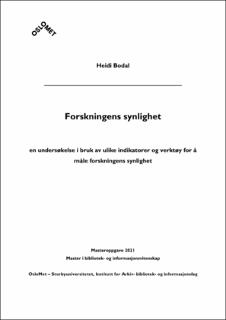| dc.contributor.advisor | Pharo, Nils | |
| dc.contributor.author | Bodal, Heidi | |
| dc.date.accessioned | 2022-02-16T12:53:14Z | |
| dc.date.available | 2022-02-16T12:53:14Z | |
| dc.date.issued | 2021 | |
| dc.identifier.uri | https://hdl.handle.net/11250/2979380 | |
| dc.description.abstract | Hensikten med denne masteroppgaven er å undersøke hvordan bruk av ulike indikatorer og verktøy kan måle synligheten av forskning, og å utforske bibliometriske metoder innenfor ulike fagdisipliner for dette formålet. Undersøkelsen tar utgangspunkt i følgende problemstilling: Hvordan kan forskningens synlighet måles med siteringer og omtaler i sosialer medier og nettverk? Datasettet består av 550 vitenskapelige artikler rapportert til Norsk Vitenskapsindeks for perioden 2016-2019, innenfor fagfeltene: geofag, pedagogikk og utdanning og samfunnsmedisin. Siteringsdata er samlet inn med kildene Web of Science, Scopus, Dimensions og Google Scholar, og omtaler i sosiale medier og nettverk er samlet inn med Altmetric og PlumX. Resultatene viser at Altmetric.com har best dekning innen kategoriene Twitter, Blogs og News, mens PlumX har best dekning innen kategoriene Facebook og Mendeley. Sammenligningen av siteringsdata viser at Dimensions er et godt alternativ til Web of Science og Scopus, og at Google Scholar er den mest omfattende kilden for siteringsdata. Det anbefales videre forskning på å studere sammenhenger mellom antall følgere på Twitter og antall Mendeley-lesere og siteringer for å få en bedre forståelse for denne typen analyser. | en_US |
| dc.description.abstract | The aim of this master’s thesis is to investigate how the use of a various set of indicators and tools can measure the visibility of research, and to explore bibliometric methods within different subject categories for this purpose. The research question is as follows: How can the visibility of research be measured with citation counts and attention in social media and networks? My dataset consist 550 scientific articles reported to the Norwegian Scientific Index (NVI) for the years 2016-2019 within the scientific fields: earth sciences, education and educational research and public, environmental and occupational health. The sources of citation data such as Web of Science, Scopus, Dimensions and Google Scholar has been compared for differences within citation counts, and the altmetric providers Altmetric.com and PlumX has been compared for differences within altmetrics. Results show that Almetric.com has the best coverage of tweets, blogs and news, while PlumX has the best coverage of facebook and Mendeley readers. Results show that Dimensions might serve as a good alternative to Web of Science and Scopus, and Google Scholar is the most comprehensive source for citation data. Further research to examine the relationship between followers to a Twitter account, the number of Mendeley readers and citations is recommended to gain a deeper understanding for this type of analyzes. | en_US |
| dc.language.iso | nob | en_US |
| dc.publisher | OsloMet - Storbyuniversitetet | en_US |
| dc.subject | Bibliometriske indikatorer | en_US |
| dc.subject | Siteringsanalyser | en_US |
| dc.subject | Altmetrics | en_US |
| dc.subject | PlumX | en_US |
| dc.subject | Dimensions | en_US |
| dc.subject | Google Scholar | en_US |
| dc.title | Forskningens synlighet: en undersøkelse i bruk av ulike indikatorer og verktøy for å måle forskningens synlighet | en_US |
| dc.title.alternative | Research Visibility: a study in the use of a various set of indicators and tools to measure the visibility of research | en_US |
| dc.type | Master thesis | en_US |
| dc.description.version | publishedVersion | en_US |
| dc.source.pagenumber | 119 | en_US |
| dc.subject.nsi | VDP::Social science: 200::Library and information science: 320::Bibliometrics: 324 | en_US |
